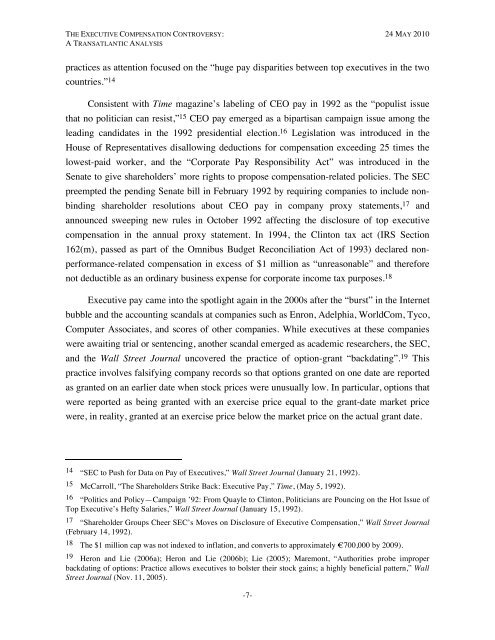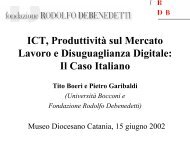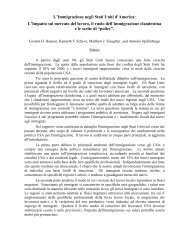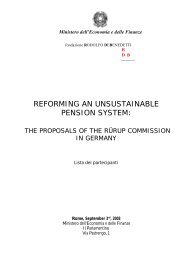The Executive Compensation Controversy - Fondazione Rodolfo ...
The Executive Compensation Controversy - Fondazione Rodolfo ...
The Executive Compensation Controversy - Fondazione Rodolfo ...
You also want an ePaper? Increase the reach of your titles
YUMPU automatically turns print PDFs into web optimized ePapers that Google loves.
THE EXECUTIVE COMPENSATION CONTROVERSY: 24 MAY 2010A TRANSATLANTIC ANALYSISpractices as attention focused on the “huge pay disparities between top executives in the twocountries.” 14Consistent with Time magazine’s labeling of CEO pay in 1992 as the “populist issuethat no politician can resist,” 15 CEO pay emerged as a bipartisan campaign issue among theleading candidates in the 1992 presidential election. 16 Legislation was introduced in theHouse of Representatives disallowing deductions for compensation exceeding 25 times thelowest-paid worker, and the “Corporate Pay Responsibility Act” was introduced in theSenate to give shareholders’ more rights to propose compensation-related policies. <strong>The</strong> SECpreempted the pending Senate bill in February 1992 by requiring companies to include nonbindingshareholder resolutions about CEO pay in company proxy statements, 17 andannounced sweeping new rules in October 1992 affecting the disclosure of top executivecompensation in the annual proxy statement. In 1994, the Clinton tax act (IRS Section162(m), passed as part of the Omnibus Budget Reconciliation Act of 1993) declared nonperformance-relatedcompensation in excess of $1 million as “unreasonable” and thereforenot deductible as an ordinary business expense for corporate income tax purposes. 18<strong>Executive</strong> pay came into the spotlight again in the 2000s after the “burst” in the Internetbubble and the accounting scandals at companies such as Enron, Adelphia, WorldCom, Tyco,Computer Associates, and scores of other companies. While executives at these companieswere awaiting trial or sentencing, another scandal emerged as academic researchers, the SEC,and the Wall Street Journal uncovered the practice of option-grant “backdating”. 19 Thispractice involves falsifying company records so that options granted on one date are reportedas granted on an earlier date when stock prices were unusually low. In particular, options thatwere reported as being granted with an exercise price equal to the grant-date market pricewere, in reality, granted at an exercise price below the market price on the actual grant date.14 “SEC to Push for Data on Pay of <strong>Executive</strong>s,” Wall Street Journal (January 21, 1992).15 McCarroll, “<strong>The</strong> Shareholders Strike Back: <strong>Executive</strong> Pay,” Time, (May 5, 1992).16 “Politics and Policy—Campaign ’92: From Quayle to Clinton, Politicians are Pouncing on the Hot Issue ofTop <strong>Executive</strong>’s Hefty Salaries,” Wall Street Journal (January 15, 1992).17 “Shareholder Groups Cheer SEC’s Moves on Disclosure of <strong>Executive</strong> <strong>Compensation</strong>,” Wall Street Journal(February 14, 1992).18 <strong>The</strong> $1 million cap was not indexed to inflation, and converts to approximately €700,000 by 2009).19 Heron and Lie (2006a); Heron and Lie (2006b); Lie (2005); Maremont, “Authorities probe improperbackdating of options: Practice allows executives to bolster their stock gains; a highly beneficial pattern,” WallStreet Journal (Nov. 11, 2005).-7-









